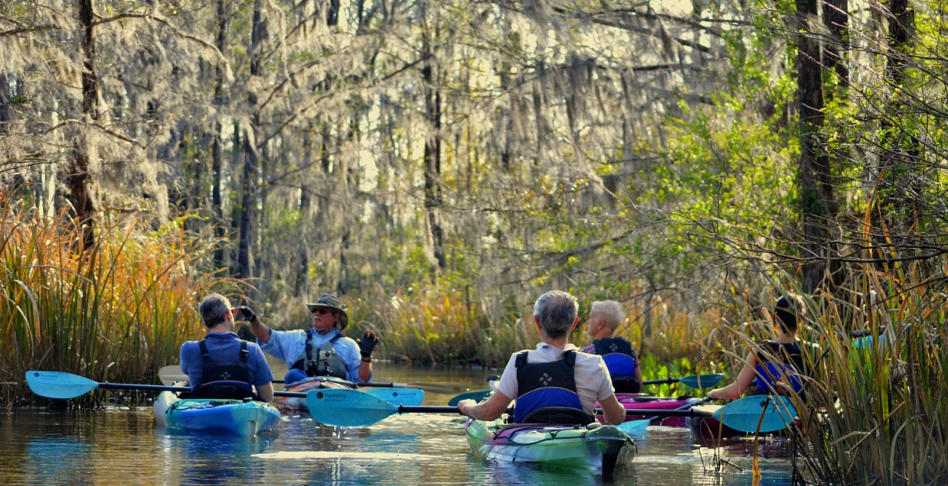Estuaries are often referred to as the “nurseries of the sea” due to their unique blend of freshwater and saltwater environments. These transitional ecosystems are rich in biodiversity and serve as vital habitats for countless species of plants, animals, and birds. Exploring estuaries by kayak offers a one-of-a-kind opportunity to immerse oneself in these vibrant ecosystems, providing unparalleled access to hidden coves, winding channels, and abundant wildlife. In this article, we will delve into the wonders of estuaries and uncover the joys of kayaking through these rich ecosystems.
Understanding Estuaries
What are Estuaries?
Estuaries are semi-enclosed coastal bodies of water where freshwater from rivers and streams meets and mixes with saltwater from the ocean. These dynamic environments are influenced by tides, currents, and varying levels of salinity, creating a habitat mosaic that supports a wide array of life forms.
Ecological Significance
Estuaries play a crucial role in supporting biodiversity and are often teeming with life. They serve as nurseries for many marine species, providing sheltered areas for juvenile fish, crustaceans, and shellfish to grow and develop. Additionally, estuaries act as important feeding grounds and resting areas for migratory birds, making them essential stopover points along avian migration routes.
Types of Estuaries
Estuaries come in various shapes and sizes, each with its own unique characteristics and ecological dynamics. Common types include coastal plain estuaries, bar-built estuaries, and tectonic estuaries. Examples of well-known estuarine ecosystems include the Chesapeake Bay in the United States, the Sundarbans in Bangladesh and India, and the Great Barrier Reef Lagoon in Australia.
Benefits of Exploring Estuaries by Kayak
Accessibility
Kayaking provides an excellent means of exploring estuaries, offering unparalleled access to shallow waters and narrow channels that may be inaccessible by larger vessels. The maneuverability of kayaks allows adventurers to navigate through dense mangrove forests, winding tidal creeks, and hidden coves, providing a truly immersive experience in these unique ecosystems.
Close Encounters with Wildlife
One of the most rewarding aspects of kayaking in estuaries is the opportunity for up-close encounters with wildlife. From graceful herons and egrets to playful dolphins and manatees, estuarine environments are home to a diverse array of species. Kayakers can quietly glide through the water, observing animals in their natural habitat without disturbing or causing undue stress to the wildlife.
Physical and Mental Health
In addition to the ecological benefits, kayaking in estuaries offers numerous advantages for physical and mental well-being. Paddling through serene waters surrounded by lush vegetation can provide a sense of tranquility and relaxation, reducing stress and promoting mental clarity. Furthermore, the physical exertion required for kayaking offers a low-impact cardiovascular workout, benefiting both physical fitness and overall health.
Safety Precautions and Preparation
Understanding Tides and Currents
Tides and currents play a significant role in estuarine environments and can greatly affect kayaking experiences. It is essential for kayakers to familiarize themselves with tidal cycles and understand how they influence water levels and currents within the estuary. Planning kayaking trips around tidal patterns can help ensure safe navigation and enjoyable outings.
Weather Considerations
Weather conditions can vary widely in estuarine environments, impacting visibility, wind patterns, and overall safety for kayakers. Before embarking on a kayaking adventure, it is crucial to check weather forecasts and be prepared for changes in conditions. Windy conditions can create choppy waters and challenging paddling conditions, while rain and thunderstorms can pose additional risks.
Safety Gear and Equipment
Proper safety gear and equipment are essential for a safe and enjoyable kayaking experience in estuaries. Every kayaker should wear a personal flotation device (PFD) at all times, as well as appropriate clothing and footwear for immersion in water. Additionally, kayakers should carry essential safety equipment such as a whistle, signaling devices, a first aid kit, and a navigation aid such as a map or GPS device.
Planning Your Estuarine Adventure
Choosing a Location
When planning a kayaking trip in an estuary, it’s essential to research and select a suitable location based on your skill level, interests, and preferences. Consider factors such as accessibility, amenities (e.g., launch points, restroom facilities), and the diversity of wildlife and habitats within the estuary. Popular estuarine destinations for kayaking include national parks, wildlife refuges, and coastal preserves.
Route Planning
Before setting out on your kayaking adventure, take the time to map out your route within the estuary. Identify points of interest such as scenic overlooks, bird rookeries, and hidden tidal creeks that you’d like to explore. Pay attention to potential hazards such as shallow shoals, submerged obstacles, and strong currents, and plan your route accordingly to avoid unnecessary risks.
Permits and Regulations
Before launching your kayak into an estuary, be sure to familiarize yourself with any permits or regulations that may apply to recreational boating in the area. Some estuarine ecosystems may have specific rules and guidelines for kayakers, such as restrictions on wildlife viewing or designated kayak trails. It’s essential to respect these regulations to minimize your impact on the environment and ensure a positive experience for yourself and others.
Tips for a Memorable Estuarine Kayaking Experience
Timing Your Trip
To maximize your chances of encountering wildlife and enjoying favorable weather conditions, consider timing your kayaking trip to coincide with the optimal times of day or year for estuarine exploration. Early mornings and late afternoons are often ideal for wildlife viewing, as many animals are most active during these times. Additionally, certain seasons may offer unique opportunities for observing migratory birds or other seasonal wildlife.
Packing Essentials
When preparing for a kayaking adventure in an estuary, it’s essential to pack wisely and bring along all the necessary gear and supplies for a safe and enjoyable outing. Some essential items to consider packing include sunscreen, insect repellent, plenty of water, snacks, a waterproof camera or binoculars for wildlife viewing, and a dry bag or waterproof container to protect your belongings from water exposure.
Respecting the Environment
As stewards of the environment, it’s crucial for kayakers to practice responsible and sustainable behavior while exploring estuarine ecosystems. Follow Leave No Trace principles, such as packing out all trash, avoiding disturbance to wildlife, and staying on designated waterways and trails to minimize your impact on sensitive habitats. By respecting the environment and wildlife, you can help preserve the beauty and integrity of estuaries for future generations to enjoy.
Conclusion
Exploring estuaries by kayak offers a unique and rewarding opportunity to connect with nature and discover the rich biodiversity of these dynamic ecosystems. From the tranquil waters of coastal marshes to the bustling channels of tidal creeks, kayakers can immerse themselves in the beauty and serenity of estuarine environments, encountering a diverse array of wildlife along the way. By following safety precautions, planning carefully, and respecting the environment, kayakers can enjoy memorable adventures while contributing to the conservation and preservation of these invaluable natural resources. So, grab your paddle, don your PFD, and embark on your own estuarine kayaking adventure it’s sure to be an experience you’ll never forget.















